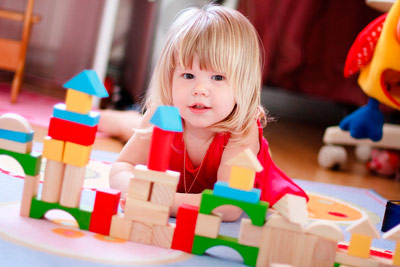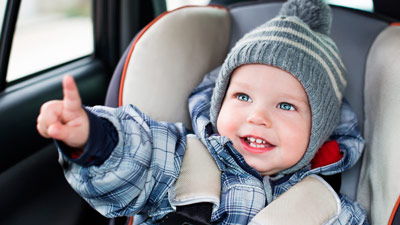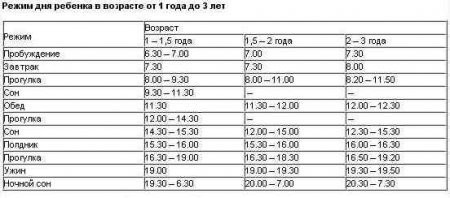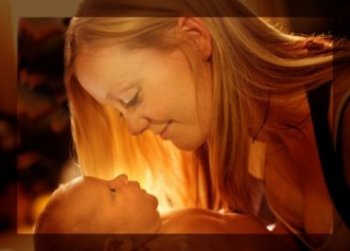This section covers the second and third years of a child's life. In place of colic, the first feeding and night vigils comes a conscious desire to actively develop in all respects. The most basic desire of the crumbs at this age is the desire for independence: the baby begins to walk, tries to hold a spoon on his own, speak, interact with others and in all ways subject to him to know the world around him.
In the subsection " child learns to speak” talks about how, after a year, baby talk is gradually replaced by formalized speech, what needs to be done to stimulate this process, to help the child enrich his vocabulary. You will find out why reading is so important for a child of 1-2 years old short stories, rhymes, viewing book illustrations, and listening to audiobooks together. How the accumulated “passive” vocabulary will grow into “active”, and when the child finally makes a new leap in speech development and speaks in phrases and sentences, improving his speech and pronunciation with each phrase.
About what natural growth difficulties parents will face in the second and third years of a baby’s life, is described in the subsections devoted to these ages: “ Child 1.5 years», « Child 2 years old», « Child 2.5 years". Expert psychologists will explain what a "crisis of 2 years" is, how it manifests itself and what parents should do to get out of it without psychological losses for themselves and the baby. In the same place, read about how to cope with tantrums, whims and stubbornness at this age, and how to direct the baby's energy into a productive channel.
Experts in early child development tell you how to develop strengths child and discover his talents. Often, one and a half year old babies have an interest in music. They love to listen to songs, try to sing, dance to the beat of the melody. We have devoted several interesting articles to the topic of developing the child's musical and artistic abilities. Read about how best to teach a child to draw, play musical instruments.
The period from one year to the moment the child turns 3 is also important for intellectual development baby. The main thing here is not to rush development, but also to create the ground for growth in time. Is it necessary to teach a child to read in a year, or in 2? About methods of early learning to read, count, about different schools early development- from Montessori to the Waldorf School, from Zaitsev cubes before Glen Doman method, - all this you will find in the subsection " Early development».
A child from one to three learns not only drawing and counting. He masters the most important activity for his age - the game. He plays with toys and makes his first playmates. What should be toys at this age? What games should kids play? Is it possible to introduce a child to gadgets at this age? How do psychologists and early childhood development experts feel about “educational” apps for iPads and other toddler tablets? Read the articles in the "Child 1-2 years" section.
After a year, the number of products “allowed” for children increases significantly, which allows parents to diversify the menu. For information on how to introduce new foods into the diet of a child after a year, what exactly and in what quantity can be given to a baby in the second and third year of life - read in the section "Nutrition of a child after a year".
In the section "Child 1-2 years" you will also find important information about child health after a year. What examinations and examinations should a baby undergo in the second and third years of life and how often? Which vaccinations do at this age? ABOUT prevention of acute respiratory infections and SARS, we also talk about methods of hardening and strengthening immunity in this section.
The Montessori methodology is built on the principles of free choice and independence, and these ideas are very close to modern parents. Despite this, a variety of rumors persist around the mega-popular doctrine and its founder.
Sounds help bring order into the life of a small child, make his daily discoveries more attractive, accompany games and accompany communication with parents ... That is, they directly participate in the development of the baby.
It seems that the baby is madly in love with climbing over the side of his crib. You like it much less, because you are worried about its safety. It's time to think about how to wean the baby from these sorties.
At the age of one and a half years there is a rapid leap in development. In addition to the usual repetition of actions, the baby learns to analyze information. He actively learns the world, shows the first independence. Social and intellectual skills are actively developed. Many parents are concerned about the question, what should a child be able to do at the age of one and a half?
Intelligence Development
At this age, the child is quite capable of distinguishing the shapes of objects, i.e. from the proposed options, choose a cube or a ball. The education of the child must be game form so that the interest of the young researcher does not disappear.
At 18 months, children show interest in matching objects of a certain shape for various holes. Attempts are not always successful, but over time the skill becomes more and more developed.
The child already understands the difference in the sizes of objects. Small and large toys can also be used in group play.
Many children at this age are able to distinguish primary colors. There is no clear pronunciation yet, but to find desired shade the baby can. First of all, you should introduce the child to such colors as: blue, yellow, red and green.
Children can distinguish most of the items according to their purpose.. Mirror - look, comb - comb your hair, dance - make arbitrary movements, etc.
Even if the child does not yet speak, he may well explain his desires to his parents, and not just with a cry, but with conscious actions.
It is at the age of 1.5 years that the process of imitating the behavior of adults takes place. The kid will try to repeat all the actions that he observes around him every day.
Physical activity
 What should a child be able to do at a year and a half:
What should a child be able to do at a year and a half:
- Almost all children can walk without support
- Kids go for walks with great pleasure, showing more and more activity in the team.
- One and a half year old children begin to eat on their own, they know how to chew
- The first communication skills are manifested, not only with acquaintances, but also with other people
Toddlers are able to climb and climb stairs, squat, bend over. Some clumsiness in the actions is still present. It is not uncommon for children to fall and stumble. And in the absence of a proper sense of self-preservation, the movements of the child become very dangerous.
Children still cannot assess the threat from any objects, and excessive curiosity moves them to conquer new peaks. Children at this age should not be left alone, even if at first glance there are no dangers in the room.
They love to swing, ride slides and climb into the most inappropriate places. The baby is not yet able to assess its strength, so parents need to always be there.
They calmly hold a spoon in their hand, drink from a mug, bite off pieces of food. Toddlers become more independent in their physical activities. They are ready to wash their own hands, put away toys, brush their teeth, read. There is more and more independence.
Children are interested in all the events taking place around, the games of other children, the behavior of adults.
Height and weight
From a year to a year and a half, the weight of the baby increases by about 1300 g. In growth, children add about 6-7 cm. The circumference of the head and chest also increase by 1-1.5 cm and 1.5-2 cm, respectively.
Average height and weight at 1.5 years:
- Weight: 10200-10900g;
- Height: 80.7-82.3 cm;
- Chest circumference: 49.9-50.4 cm;
- Head circumference: 46.2-47.4 cm.
Boys at this age are usually slightly larger than girls. But normal indicators for each child are determined individually, so do not worry too much if your baby weighs a little more or a little less than normal.
In order to notice developmental disorders in time, it is necessary to know about the features of the physical, intellectual and emotional development baby in different ages. All about the skills and abilities of six-month-old crumbs - in the material ""
How developed is motor skills
 The motor skills of children aged 1.5 years are also actively developing:
The motor skills of children aged 1.5 years are also actively developing:
- The ability to unfold various packages appears
- Interest is shown in opening containers, cans, boxes
- The structure of pyramids and turrets from improvised materials
- Interest in jigsaw puzzles
- Drawing with pencils, finger paints understandable shapes and lines
- Children with interest repeat the same action several times, especially if it works well
The individual elements of large mosaics can be put in the right place by the baby, these abilities are very important to develop, such activities train fine motor skills well.
Speech skills
The vocabulary of children at the age of one and a half years is about 40 words. Do not expect clear pronunciation. Basically, in the arsenal of the child there are words that imitate sounds (bi-bi, kitty-kitty, av-av and others).
Some children can already form phrases from a couple of words. Declension and other rules of the language are not yet subject to them, but the general meaning of speech becomes clear.
It is during this period of time that the laying of the passive vocabulary children, so it is important to try to teach them to pronounce as many words as possible. The more they hear and see, the more they remember.
In the future, all this hidden knowledge is expressed in a well-developed full-fledged speech. Therefore, parents are encouraged to voice everything that happens around, both at home and on a walk.
For normal speech development children should always respond to the requests, questions and words of the baby. In adult speech, there should be no distorted words imitating sounds. The child should immediately perceive normally delivered adult speech.
If the baby still cannot speak clearly at this age, do not get upset and panic. With enough attention and regular communication, the baby will soon learn to speak in coherent sentences.
emotional development
 Children are very sensitive to the emotional background around. At this age, they are already able to feel drastic changes in the mood of an adult. With the joy and anger of the mother, the baby begins to understand what is happening.
Children are very sensitive to the emotional background around. At this age, they are already able to feel drastic changes in the mood of an adult. With the joy and anger of the mother, the baby begins to understand what is happening.
Already at 1.5 years old, children copy the behavior and expression of adult emotions. With the help of screams, crying and joyful cries, the child learns to draw attention to himself.
The child's social skills become noticeable. Imitating adults, he can kiss, hug or comfort another person. But such manifestations rarely occur at the initiative of the child.
Most often they fulfill the request of adults. At the age of one and a half years, the baby can easily change one emotion for another almost instantly. Loud crying is replaced by joy, tears of resentment turn into a smile.
household skills
 What can a child at this age do?
What can a child at this age do?
- With the increasing independence of the child, the development of household skills also occurs.
- Children show interest in self-dressing.
- The child becomes an active assistant in everyday matters
The baby confidently holds a spoon and makes the first attempts to eat and drink on his own. To begin with, it is better to offer thick food until the skill is fully formed. There are other skills as well.
Most often this applies to hats and mittens. Parents should encourage the child's independent attempts, be patient, even if the dressing process takes about an hour. After the baby dresses himself, you should praise him.
He can take items to the trash can, wipe the floor with a rag, wash the table, try to do many many other household chores. All actions of the child copy the activities of adults. Many one and a half year old children are already asking to go to the toilet. They enjoy washing their hands or brushing their teeth.
social behavior
The behavior of children at the age of 1.5 years is becoming more and more calm. Of course, tantrums and whims can still happen, but the baby learns to express his emotions in other ways.
With a harmonious relationship between children and parents, at this age the baby becomes very affectionate and caring. He can take pity and hug his mother, gently hold her hand.
The first interest of children in joint games appears. The kids enjoy watching each other. But in the process of such communication, fights and resentments often arise, because. children still do not know how to properly communicate, share, give in. A distraction will always help to get out of a difficult situation. Switching the baby's attention is not difficult.
During this period, children are still more interested in playing with adults., because there is still no proper level of speech development. But in the future, there will be more and more interest in other children.
Schedule
At the age of 1.5 years, as in earlier periods, you need a clear daily routine. The periods of sleep and wakefulness should be separated. Proper and nutritious nutrition is an integral part of raising a healthy child.
Some children at this age continue to sleep 2 times during the day. 18 months is a great time to transition to one nap, lasting about 3 hours.
Twice daily walks are recommended. You can still walk with the baby while he sleeps. Sleeping in the fresh air is very beneficial for the child's body. For the full development of the crumbs, you should walk at least 2 hours a day.
An approximate schedule is shown in the table

The average amount of food consumed per day should be 1000-1300 ml. To more accurately determine the size of portions, you can divide the weight of the baby by 9. It is recommended to give the child no more than 250 ml of food at a time. these recommendations should be observed until the child reaches the age of two years.
The nutrition of children at this age is becoming more diverse. New products are introduced, dishes become close to adult food. It is also recommended to limit children in the consumption of junk and sweet foods.
The difference between girls and boys
At 18 months, differences in the behavior and character of children of different sexes become more and more obvious. Boys need more attention, trust and participation in life. It is recommended to give more independence to little men, accustoming them to do adult work.
Guardianship and excessive control of the actions of the baby can have a detrimental effect on self-esteem and self-confidence in the future.
Girls are becoming more sensitive and gentle. They need more affection. Features of female psychology are associated with the perception of mother's help as a manifestation of love.
Joint games with a child
Of great interest are pyramids of different shapes. Children enjoy spending time building turrets, though not always following the sequence of sizes of the figures.
Drawing can also be incorporated into a child development program. Kids try to draw on paper not just scribbles, but conscious circles, stripes, shapes.
In games with a baby, you can use several objects of the same shape. The child should easily find similar things, both in the surrounding space and in the pictures. Know the names of simple household items (comb, cup, spoon).
We advise you to look for ideas for joint games and various activities - "developers" on the Internet.
The child will interested in musical toys and any things that can make sounds. All household items, clothes and kitchen utensils beckon the young explorer.
Children's games are becoming more conscious. Now in the attention of the baby there will be not one toy, but several at once. The baby will be happy to transport the cubes in the truck, dress the doll, feed the toys.
- Regular joint activities and games with the child have a great influence on his development.
- Bright and interesting toys made of quality materials will occupy the attention of the crumbs for a long time.
- It is useful to read and view various pictures
- Independent actions and reasonable guardianship will only benefit the child
- Adult conversations, participation in the life of the household help the baby feel like an important and necessary family member
The harmonious development of the child is associated with the right approach to education. Parents who are ready to participate in the life of the baby every day will soon see an adult person next to them on their own. Thanks to the sharp development of skills at 1.5 years old, the baby becomes an increasingly interesting and intelligent interlocutor.
Doctor Komarovsky about norms and terms
From the moment of birth, the health of each baby is under the constant supervision of a pediatrician. During the first month of life, the doctor and pediatric nurse regularly examine the newborn at home and give advice to parents on caring for him. Starting from the age of 4–5 weeks, the baby will have monthly visits to the children's clinic to assess its physical and neuropsychic development. However, babies change so rapidly that fluent scheduled inspection Once a month is not enough.
Parents must constantly monitor the condition of their child in order not to miss possible deviations from the norm, which, as you know, are easier to correct, the less time has passed since they were detected. One of the most significant periods of development falls on the age of 5-7 weeks, when the foundations of many basic skills and abilities are laid. Consider what a healthy baby should be like at 1.5 months old, developing in accordance with basic pediatric standards.
The main indicators of the physical development of the baby are height, weight, head and chest circumference. Their values may differ slightly depending on the gender of the baby. According to WHO, at the age of 1.5 months, a healthy child has the following parameters:
- Height:
- 53-55 cm for girls;
- 54–56 cm for boys. - Weight:
- 4.0–5.2 kg for girls;
- 4.3–5.5 kg for a boy. - Head circumference:
- 36-38 cm for girls;
- 37–39 cm for boys. - Chest circumference:
- 36-38 cm for girls;
- 37–39 cm for boys.
Indicators may slightly deviate in one direction or another from the above average values. As a rule, if the baby is cheerful, active and looks healthy, there is no cause for concern. However, any, even the most insignificant, deviations from normal indicators should be reported to the pediatrician.
General development

By a month and a half, the period of adaptation is replaced by the so-called period of revival. The baby overcomes the first leap of development, rapidly changing both physically and emotionally. The reflexes of the newborn gradually fade away, and the baby begins to perceive the reality around him more consciously. He not only recognizes mom and dad, but also expresses joy at every meeting with them: he smiles, stretches his arms. Facial expressions are actively developing, movements become more accurate and confident.
The main way to communicate with others is still crying, but the baby is already learning to “talk” by pronouncing some vowel sounds, most often “A” and “U”. From about 6-7 weeks, he begins to walk and imitate simple sounds. It is important for parents to talk with the baby as much as possible, sing songs to him and recite poems, thereby stimulating the development of speech.
The look of the baby becomes focused, he can look at the objects around him for a long time: toys, a picture on the wallpaper, his clothes. The baby is most interested in contrasting black-and-white and red-white pictures, and he still does not perceive faded and pastel colors.
Along with vision, hearing develops: the child can distinguish where the noise comes from, turns his head to the sound of a rattle or a loud conversation, recognizes the voice of his mother.
growing and physical activity. The baby can no longer lie still in place while awake. He bends, waves his legs and arms, turns his head. Gradually, the baby begins to pay attention to his hands and learns to control them: he moves his fingers, grabs a diaper, tries to hold the rattle.
Skills

At 1.5 months, the child should be able to:
- lying on your stomach, raise your head and hold it for at least a few seconds;
- lying on your side, independently turn on your back;
- hold the toy in each of the handles for a short time;
- consciously smile in response to a smile or affection.
It should be remembered that each person is unique and can develop in his own way. Nevertheless, if any deviations from the generally accepted pediatric norms are detected, it is definitely worth informing the doctor about this.
Sleep, nutrition and hygiene procedures
At this age, the baby still sleeps about 18 hours a day, but every day the total time of wakefulness becomes longer. As a rule, by 1.5 months, most babies have already formed a certain daily routine, which includes about 5-6 episodes of sleep and the same number of periods of activity.
The baby continues to eat breast milk or an adapted artificial mixture. At the same time, children on breastfeeding, it is desirable to feed on demand, without striving to comply with a clear meal plan. Artificers, on the other hand, need a stricter regime with intervals between feedings of at least 4 hours. The daily amount of milk consumed gradually increases and can reach a quarter of the weight of the baby.
The development of the crumbs significantly depends on its physical activity, which should be combined with hygiene procedures. During the morning diaper change, it is useful for the baby to do gymnastics: bend and unbend the limbs, turn over on the side and on the tummy. Starting from 5-6 weeks, the baby can be given a light massage. It should include stroking the tummy and back, arms and legs (with the exception of the lymph nodes) and light rubbing of the feet. On the heels and palms, you can roll a special massage ball with spikes.
The daily routine must necessarily include bathing in the bath. It is best to arrange a swim in the evening before the last feeding. For the safety of a small swimmer, you can use an inflatable ring worn around the neck. During washing, it is advisable to carry out simple physical exercises: rock the baby in the water, make swimming movements with the limbs.
Activities and games with the baby
![]()
It's no secret that children develop best when they play. Of course, at 1.5 months, babies are not capable of long-term activities and the conscious use of toys. However, they become interested in rattles, bright animal figures made of safe plastic or rubber, streamers and arcs above the crib. At this age, you can introduce the baby to soft toys for the little ones. They, as a rule, are sewn from fabric and contain various tactile elements: rustling inserts, elements with an unusual surface to the touch.
Daily activities should include reading and music. You can let the baby listen to an audio recording with children's songs and rhymes for a few minutes, but he reacts best to his mother's voice. Be sure to talk to the baby, call him by name, comment on all his actions when carrying out hygiene procedures or dressing.
First games for babies:
- "Mirror". Try to copy all the sounds and grimaces of the baby so that he can see and hear you well. Seeing his reflection in the face of his mother, the child knows himself better and learns to control his body and voice faster.
- "Imitation". Lay the baby on its back and bring your face close to it. Actively articulate, pronounce various sounds, slowly change facial expressions: raise your eyebrows, frown, open your mouth wide, stick out your tongue. The baby will first look with interest at the mother's face, and then begin to repeat all the actions after her.
- Lie on your back and place the baby belly on your stomach. Talk to him or show him bright toys, leading them in front of his face from side to side. This game will allow not only to strengthen the back muscles, but also to establish closer contact with the baby.
It should be remembered that the pace of development of the child may not correspond to generally accepted standards. However, it is in your power to do everything possible so that he strives to explore the world, grows up healthy and happy.



